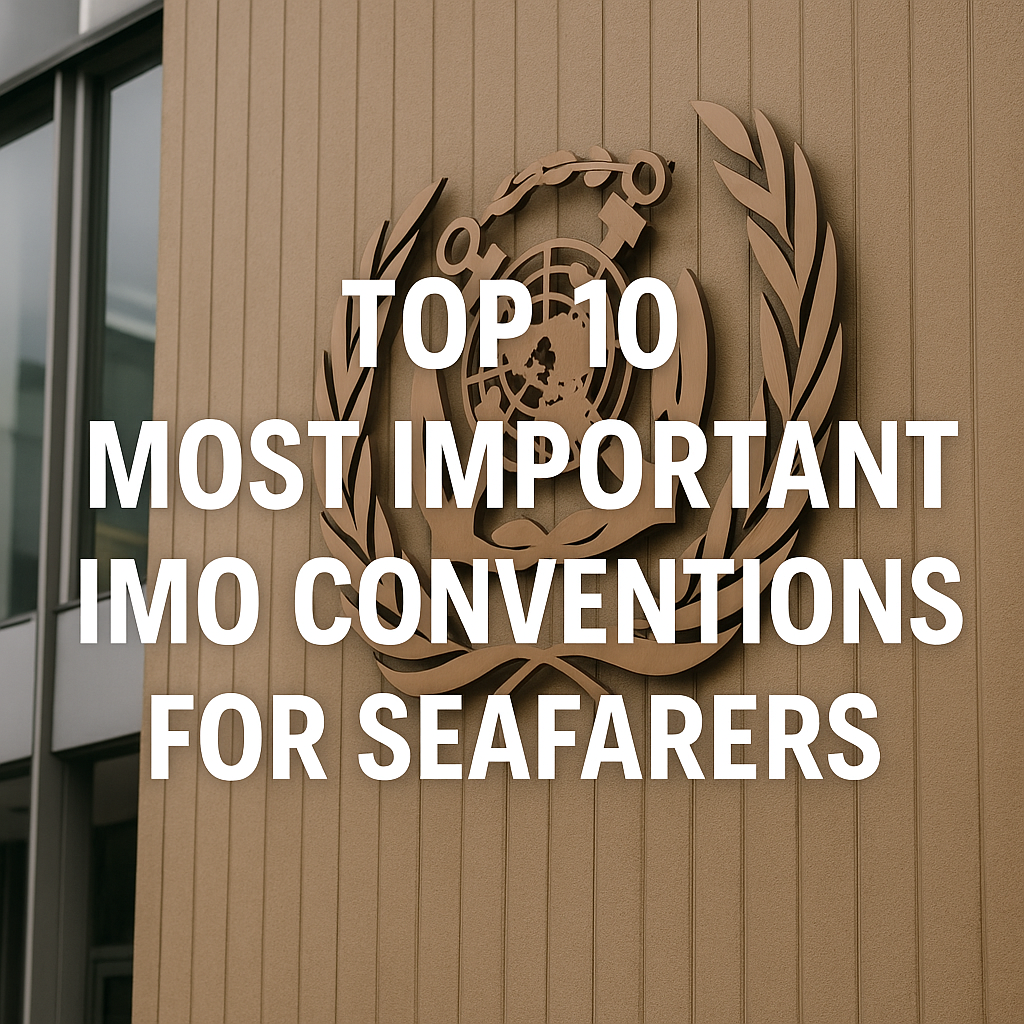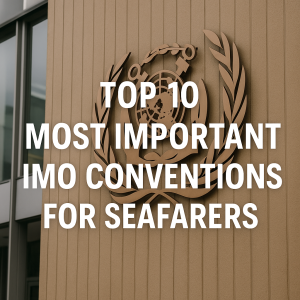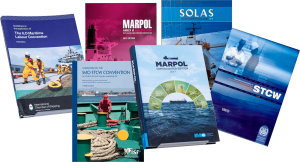Explore the top 10 most important IMO conventions for seafarers. Understand how SOLAS, MARPOL, STCW, and other critical treaties shape global maritime safety, security, and environmental compliance.
Why IMO Conventions Matter in Modern Maritime Operations
The world’s oceans connect more than just continents—they bind economies, cultures, and global supply chains. But with over 50,000 merchant ships transporting 90% of world trade, safety, security, and environmental stewardship at sea cannot be left to chance. This is where the International Maritime Organization (IMO) plays a pivotal role.
Established in 1948 as a specialized UN agency, the IMO sets global standards for the safety, security, and environmental performance of international shipping. Its conventions are legally binding frameworks that directly impact every seafarer, from cadets on their first watch to captains navigating complex international waters.
For maritime professionals, understanding the most influential IMO conventions isn’t just academic—it’s essential to safe and compliant operations. This guide explores the top 10 IMO conventions every seafarer should know, their scope, and how they apply onboard.
Understanding the IMO: The Architect of Maritime Governance
The IMO’s primary objective is to create a level playing field for international shipping while safeguarding lives, vessels, and marine ecosystems. Its conventions address:
-
Safety (e.g., SOLAS)
-
Pollution prevention (e.g., MARPOL)
-
Seafarer training and certification (e.g., STCW)
-
Labor rights (e.g., MLC, in cooperation with the ILO)
-
Security (e.g., ISPS Code)
With over 50 conventions and protocols and countless codes and amendments, staying compliant is complex—but crucial.
Top 10 IMO Conventions for Seafarers
1. SOLAS – Safety of Life at Sea (1974)
Often regarded as the cornerstone of maritime safety, SOLAS prescribes minimum standards for ship construction, fire protection, life-saving equipment, navigational systems, and emergency procedures.
Key Areas:
-
Fire detection and suppression (Chapter II-2)
-
Lifesaving appliances (Chapter III)
-
Navigation safety (Chapter V)
Real-World Relevance: During the Costa Concordia disaster in 2012, inadequate muster drills and life-saving procedures—core elements of SOLAS—were cited as major failings.
📘 Learn more about SOLAS at IMO.org
2. STCW – Standards of Training, Certification and Watchkeeping (1978, as amended)
STCW ensures that seafarers have uniform, competency-based training and certification worldwide. It covers:
-
Basic and advanced safety training
-
Watchkeeping standards (OOW, Chief Officer, Master)
-
ECDIS, bridge resource management, and engine watchkeeping
-
Manila Amendments (2010): fatigue, security, leadership
Importance for Seafarers: Every license and sea-time endorsement is governed by STCW. Without STCW certificates, a seafarer is legally barred from working internationally.
3. MARPOL – Marine Pollution Convention (1973/78)
MARPOL is the international standard for preventing pollution from ships. It consists of six annexes that address pollution from:
-
Oil (Annex I)
-
Noxious liquids (Annex II)
-
Harmful substances (Annex III)
-
Sewage (Annex IV)
-
Garbage (Annex V)
-
Air emissions (Annex VI)
Recent Update: Annex VI now limits sulfur emissions to 0.50% m/m, under the IMO 2020 regulation, reducing harmful air pollution globally.
🌊 Seafarer Responsibility: Every watchkeeper must understand the Oil Record Book, Garbage Management Plan, and SOx/NOx compliance.
4. COLREG – Convention on the International Regulations for Preventing Collisions at Sea (1972)
Known as the “rules of the road,” COLREGs govern vessel conduct to avoid collisions.
Key Rules:
-
Navigation lights and shapes
-
Right-of-way
-
Lookout responsibilities
-
Overtaking and crossing rules
Example: In 2017, the USS Fitzgerald collision off Japan highlighted critical violations of COLREGs, emphasizing the need for strict compliance.
5. ISM Code – International Safety Management Code (1998)
The ISM Code sets the standard for safe ship operation and pollution prevention through company-level and vessel-level Safety Management Systems (SMS).
Seafarer Role:
-
Participate in drills and audits
-
Maintain operational checklists
-
Report non-conformities
Why It Matters: ISM empowers all crew members to report safety issues without fear of retaliation, fostering a culture of proactive risk management.
6. ISPS Code – International Ship and Port Facility Security Code (2004)
Developed after 9/11, the ISPS Code enhances the security of ships and port facilities.
Key Requirements:
-
Ship Security Plans (SSP)
-
Security drills and alert systems
-
Access control and threat response
Seafarer Duty: Understand your role during security level changes, drills, and restricted area protocols.
📘 Review ISPS guidance at IMO.org
7. MLC – Maritime Labour Convention (2006)
Also known as the “Seafarers’ Bill of Rights”, the MLC, administered by the International Labour Organization (ILO), sets global standards for:
-
Minimum working conditions
-
Contract transparency
-
Shore leave
-
Repatriation and crew welfare
Impact: Protects against exploitation and substandard conditions, ensuring a safe, fair working environment.
8. LOAD LINE Convention (1966/88 Protocol)
This convention defines the maximum permissible draft, ensuring vessel buoyancy and stability.
Key Elements:
-
Plimsoll Line (visible marking on hull)
-
Seasonal and regional adjustments
-
Freeboard calculations
Seafarer Task: Monitor ballast operations, ensure hatch covers are sealed, and comply with loading restrictions.
9. SAR – International Convention on Maritime Search and Rescue (1979)
SAR establishes a global framework for search and rescue coordination, often implemented via national MRCCs (Maritime Rescue Coordination Centers).
Seafarer Role:
-
Respond to distress calls
-
Provide assistance under SOLAS Chapter V, Regulation 33
🌐 Example: During the Mediterranean migrant crisis, many merchant ships were called upon under SAR obligations to assist overcrowded boats.
10. Ballast Water Management Convention (2004)
Introduced to combat invasive marine species, this convention requires vessels to manage or treat ballast water before discharge.
Seafarer Impact:
-
Operate and record treatment systems
-
Ensure sampling compliance
-
Monitor discharge schedules
📘 IMO Ballast Convention Details
Case Study: SOLAS in Action—The MV Almirante Storni Fire
In 2021, a container fire aboard the Almirante Storni off Sweden tested the vessel’s compliance with SOLAS fire protection standards. Thanks to:
-
Effective fire detection systems
-
Trained crew
-
Functional CO₂ suppression
…the fire was contained, and no lives were lost. The case highlighted the critical role of SOLAS Chapter II-2 and ISM Code preparedness.
Frequently Asked Questions (FAQ)
Q1: Are IMO conventions mandatory for all ships?
A: Yes, for vessels registered under flag states that have ratified them—this includes nearly all international trading nations.
Q2: How do seafarers keep track of these conventions?
A: Via company training, SMS manuals, STCW certification courses, and regulatory updates from flag state circulars and port state control bulletins.
Q3: What’s the difference between a convention and a code?
A: Conventions are international treaties; codes (like ISM or ISPS) detail how to implement them effectively.
Q4: Can failure to follow IMO conventions result in detention?
A: Absolutely. Port State Control (PSC) inspections can detain vessels for non-compliance with safety or environmental standards.
Q5: Which is the most important IMO convention for new cadets?
A: STCW is foundational—it governs your training, certification, and onboard duties from day one.
Conclusion: Knowing the Rules That Keep the Oceans Safe
For seafarers, knowledge of IMO conventions is more than regulatory trivia—it’s the foundation of responsible, legal, and safe navigation. These conventions reflect decades of lessons learned from accidents, environmental disasters, and operational inefficiencies.
By mastering these conventions, seafarers don’t just meet legal requirements—they uphold the values of maritime professionalism, environmental stewardship, and human safety at sea.
⚓ Want to dive deeper into STCW training, SOLAS compliance, or MARPOL recordkeeping? Visit MaritimEducation.com for up-to-date guides, certification prep, and course resources.
References
-
International Maritime Organization. (2024). List of IMO Conventions. https://www.imo.org
-
International Labour Organization. (2023). MLC 2006 Guide. https://www.ilo.org
-
IHO. (2023). E-Navigation Guidelines. https://iho.int
-
ICS. (2022). Maritime Safety Compliance Manual. https://www.ics-shipping.org




Appreciate the recommendation. Will try it out.